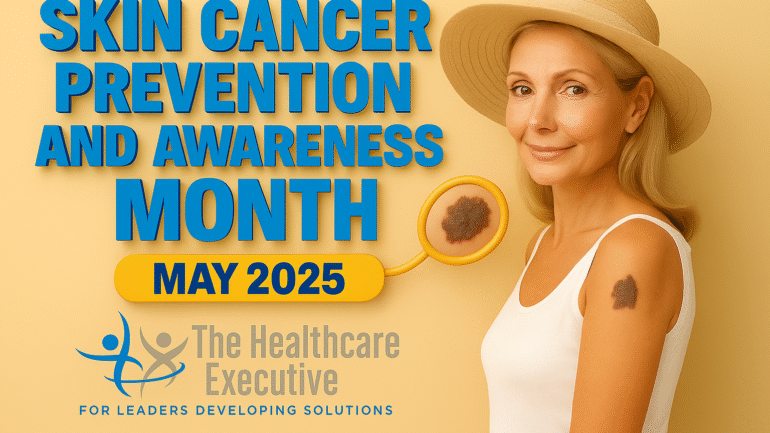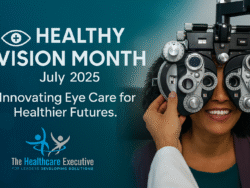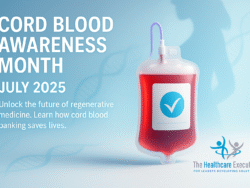Skin Cancer Prevention and Awareness Month – May 2025

- Posted by Greg Wahlstrom, MBA, HCM
- Posted in Health Observance Calendar
Hospital Leadership in Early Detection and Sun Safety
Published: May 1, 2025
Each May, Skin Cancer Prevention and Awareness Month invites healthcare executives to lead efforts in sun safety, early detection, and community outreach. With over 5 million cases of skin cancer diagnosed annually in the U.S., including 7,000 melanoma‑related deaths, prevention must be a strategic healthcare priority. Melanoma remains one of the deadliest cancers when diagnosed late—an outcome long acknowledged by oncology researchers for its aggressive progression and poor prognosis in advanced stages (Tragedy of Melanoma, PubMed). Nearly three decades later, the data urgently. A 2022 review in Cancers emphasized that “skin cancer is largely preventable,” with UV exposure still being the most significant modifiable risk factor (Emanuel, et al., 2022). For hospital leaders, this observance is more than awareness—it’s a call to operationalize prevention through screening protocols, provider training, and patient education. Organizations must evaluate infrastructure, such as dermatology access, teledermatology, and skin exam workflows in emergency and primary care. Executive investment in mobile screening units and public health partnerships can drive measurable reductions in preventable cancer. National models—like UV‑safety programs at major cancer centers—show how system‑level commitment can yield population impact. Preparing for this month means affirming sun safety as a mission‑aligned, equity‑driven priority across the patient journey.
From a systems perspective, embedding skin safety into operations requires multi‑departmental coordination. Hospital teams should integrate skin screenings into EHR prompts for routine visits, especially among high‑risk groups such as outdoor workers, older adults, and fair‑skinned individuals. Dermatology departments can pilot AI‑ or dermoscopy‑supported tools, enabling front‑line providers to document suspicious lesions and initiate timely referrals. Some institutions have implemented teledermatology kiosks in rural and community settings, improving access and reducing wait times. Clinical staff must be trained to identify concerning moles in all skin tones and escalate properly. According to the StatPearls Handbook on Skin Cancer Screening, early identification through primary care integration significantly improves survival outcomes, especially in melanoma and squamous cell carcinoma (NCBI). Pharmacy and outpatient outlets can also reinforce sun safety through patient education and product availability. Executive oversight should include performance audits to track screening uptake, referral timeliness, and clinical outcomes. Prevention becomes operational when systems allocate resources to staff, technology, and monitoring across the cancer care continuum.
Skin cancer prevention is also a health equity imperative. While public messaging often targets fair‑skinned individuals, melanoma and non‑melanoma skin cancers affect people of color too—and are frequently diagnosed at later, more dangerous stages. Hospitals must create culturally responsive campaigns with inclusive imagery, multilingual materials, and community partnerships. For example, mobile screening vans visiting faith‑based organizations and recreation sites can bridge access gaps. Community health workers and dermatology nurse navigators can facilitate follow‑up care and increase engagement in underserved communities. “Incorporating social risk information into clinical practice has the potential to improve the effectiveness of preventive services by allowing clinicians to tailor care to patients’ individual needs and circumstances,” according to a 2021 technical brief by the U.S. Preventive Services Task Force. Social risk factors—such as housing, food insecurity, and neighborhood context—must also be considered in tailoring prevention strategies for marginalized populations. Performance dashboards should stratify skin cancer metrics by race, ethnicity, and geography, highlighting disparities and driving targeted interventions. By intentionally aligning prevention with equity goals, hospitals demonstrate leadership in reducing preventable disease and upholding social justice in healthcare outcomes.
Executive teams should treat May as an impetus for action—not just visibility. Key performance metrics include percentage of eligible patients screened, referral turnaround times, and sun safety education reach. Hospitals like Intermountain Health have embedded these metrics into quality scorecards tied to incentive funding. Budget planning should consider teledermatology platforms, public‑facing outreach programs, and staff training in skin lesion detection. Executive dashboards can track progress year‑over‑year and benchmark against peer institutions. Hospital boards should be briefed on prevention program performance, resource allocation, and system impact. Prevention efforts may also shape payer negotiations under value‑based care models, emphasizing long‑term cost savings through early intervention. Leadership during Skin Cancer Prevention Month signals a proactive, patient‑centric strategy.
Public credibility relies on transparent communication and community engagement. Hospitals can host dermatologist-led webinars, mobile educational events, and media-sponsored sun safety campaigns. Featuring survivor stories and leadership participation heightens visibility and trust. As noted by Yale School of Medicine, “We’re bringing sun protection to the places people already gather, removing barriers to access, and making prevention part of daily life.” At Yale New Haven Health, proactive messaging during May has driven measurable increases in annual skin checks and sunscreen purchases. In a related effort, Yale School of Medicine has collaborated with city leaders to distribute free sunscreen in public parks and provide culturally tailored education about sun safety. Executive presence at awareness events—whether virtual or campus-based—reinforces organizational commitment. Hospitals that step forward during May demonstrate a broader dedication to prevention, not only in headline months but as enduring institutional practice. May should be the launchpad, not the finish line, for advancing sun-smart culture and clinical resilience.
Discover More
Interested in building a hospital‑wide sun safety and cancer prevention strategy? Our editorial content supports healthcare leaders in integrating clinical excellence, population health, and community engagement.
Internal Resources
- National Cancer Prevention Month 2025: Executive Strategy for Early Intervention
- Advancing Patient Safety Standards: A 2024 Action Plan for Healthcare Executives
- National Women’s Health Month 2025: Hospital Equity and Screening Access
External Links
- CDC – Skin Cancer Prevention
- American Cancer Society – Skin Cancer Facts
- The Skin Cancer Foundation
- Kricker A, Armstrong BK, English DR. Sun exposure and non-melanocytic skin cancer. Cancer Causes Control. 1994 Jul;5(4):367-92. doi: 10.1007/BF01804988. PMID: 8080949
- Dennis, L. K. (2022). Cumulative Sun Exposure and Melanoma in a Population-Based Case–Control Study: Does Sun Sensitivity Matter? Cancers, 14(4), 1008. https://doi.org/10.3390/cancers14041008
- US Department of Health and Human Services. The Surgeon General’s Call to Action to Prevent Skin Cancer. Washington (DC): Office of the Surgeon General (US); 2014. Calls to Action.Available from: https://www.ncbi.nlm.nih.gov/books/NBKhttps://www.ncbi.nlm.nih.gov/books/NBK247176/247176/
- Screening and Interventions for Social Risk Factors: A Technical Brief to Support the U.S. Preventive Services Task Force
- Yale School of Medicine. (2023, May 25). Preventing skin cancer with free sunscreen and community outreach. Yale News. https://medicine.yale.edu/news-article/preventing-skin-cancer-with-free-sunscreen-and-community-outreach/



